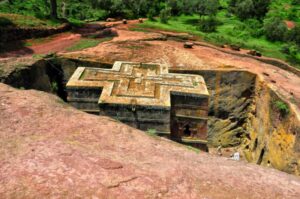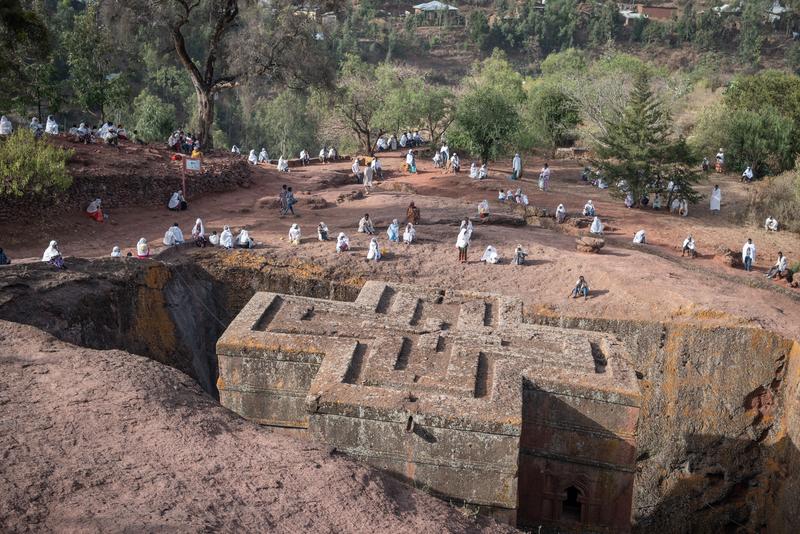
Lalibela is a town of 25,000 inhabitants located in the Amhara Region in the northern part of Ethiopia and it’s a must-see for anyone visiting the country. Known as ‘New Jerusalem’, it was constructed by the King of Lalibela after the Muslim seizure of Jerusalem in 636 or 637 AD as a site for Ethiopian Orthodox Christians who could not make the pilgrimage to the Holy Land. Lalibela sits at an altitude of over 2,600 metres and is set within a rugged, mountainous landscape where the air is fresh and the pace is slow – a stark contrast to the busy capital city of Addis Ababa! Despite its sleepy, rural vibe, Lalibela is a place that’s steeped in history and rich in culture.
Lalibela is most notably known as a UNESCO World Heritage site, home to 11 majestic and awe-inspiring rock-hewn churches dating back to the 13th century. Set within a labyrinth of trenches and subterranean passages, these monolithic ‘cave churches’ were carved and chiseled by hand from red volcanic rock and they are a truly incredible feat of ancient engineering, persistence, and religious dedication! The monolithic architecture is remarkable on its own, but when you add in the extra touches like the decorative doorways, windows and murals, the beauty of the churches becomes even more astonishing. The skill involved in carving these churches out of solid monolithic blocks of granite down to 25 metres is mind-blowing and Lalibela truly needs to be seen to be believed.
The churches of Lalibela were one of the very first conservation projects taken on by the World Monuments Fund in the 1960s and they have successfully performed a variety of documentation and stabilisation work on the churches since then. Their goal is to help preserve these amazing buildings far into the future by creating a sustainable framework for preservation and training local personnel to ensure the protection of these churches far into the future.
The main draw in Lalibela is, of course, the rock-hewn churches, but the town and surrounding area has a lot to offer! A three night stay would be ideal for taking in all of the sights in and around Lalibela without being too rushed. Lalibela has two main clusters of churches, one with five churches set to the Northwest of the River Jordan, and another to the Southeast with five more churches. Additionally, there’s an isolated church called Bet Giyorgis (St. George’s) that should also be included in your visit. An interesting feature in the Northern Cluster that shouldn’t be missed is the ‘pathway to hell’, a 32 metre long tunnel carved into the stone with no lighting. Be aware that the sites close for two hours for lunch at noon and visiting hours finish at 5pm. There’s so much to see and so many legends and local customs to learn about that hiring a guide is recommended.
How to Get There
Lalibela is the crown jewel of the historic northern circuit that includes other remarkable sites such as Bahir Dar, Lake Tana, Gondar, Axum, and the Simien Mountains. It makes sense to visit many of these incredible places on the same trip from Addis Ababa, and you could visit most of the northern circuit destinations on a two week trip.
If you’d prefer to travel to Lalibela on its own, it is at least a 14 hour journey by road in a private vehicle or it can take up to two days by bus with an overnight stop along the way. This route is probably reserved for the more adventurous as the roads in Ethiopia can sometimes be a challenge and this route in particular is known as one of the worst! For those short on time who aren’t fond of bumpy roads, flying is the better option. From Addis Ababa you can fly direct to Lalibela for as little as US$80 with Ethiopian Airlines.
When To Visit Lalibela
Lalibela, and Ethiopia in general, is best visited during the dry season that runs from October to March. Visiting on a weekend is best so that you can go to the local market on Saturday and then head to the churches on Sunday where they fill with devotees taking in the dawn mass. The churches are still very much in use, especially during Ethiopian Christmas celebrated on January 7th and Timkat on January 19th where pilgrims flock to Lalibela to celebrate the two most important religious holidays of the year. If you don’t mind higher prices and large crowds, these are truly magical times to visit the area and to see this holy site filled with worshippers.
